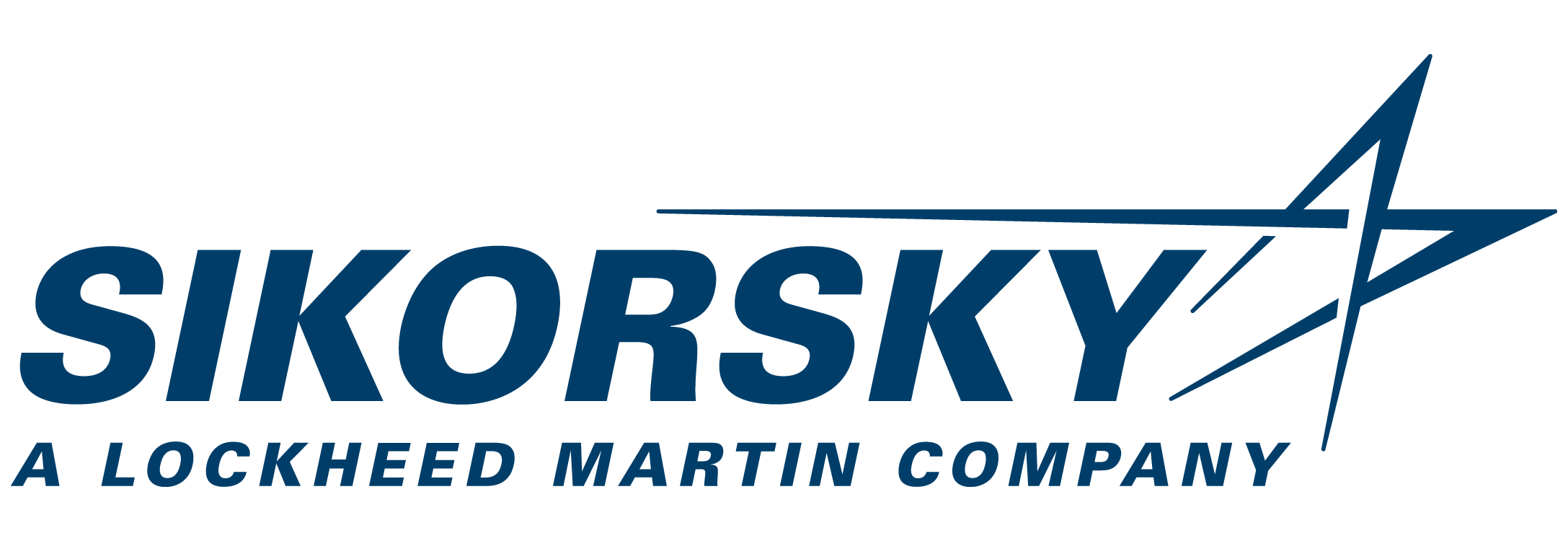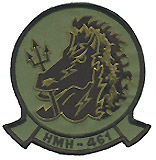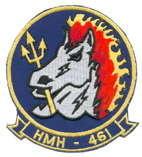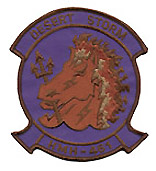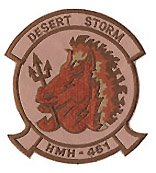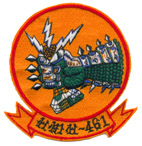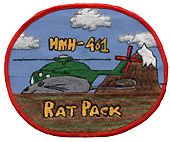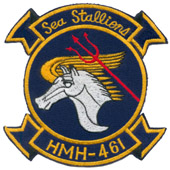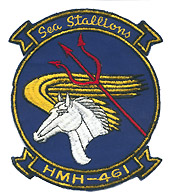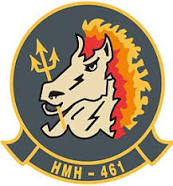
HMH-461 Squadron Patch
History of HMH-461
On 15 March 1944, Marine Fighter Squadron 461 (VMF-461), Marine Base Defense Group 43, was commissioned at El Centro, California with the F4U Corsair. During 1946 to 1949, VMF-461 was deployed aboard USS Palau (OVE 122), first as part of Marine Aircraft Carrier Group 12 and later as part of the Atlantic Fleet. In September of 1950, VMF-461 was deactivated.
In January 1957, the squadron was reactivated at MCAS New River, North Carolina as Marine Helicopter Transport Squadron (Medium) 461, (HMR(M)-461). The squadron was equipped with the HR2S-1 (later to be designated as the CH-37), which was the largest helicopter in the Marine Corps inventory at the time.
As part of the U.S. Space Program in 1961, HMR(M)-461 participated as the primary recovery vehicle for NASA AeroBee Rocket launches at Wallops Island, Virginia. In February 1962, HMR(M)-461 was redesignated Marine Heavy Helicopter Squadron 461 (HMH-461). From 1962 to 1965, HMH-461 participated in various deployments and exercises in the Mediterranean and Caribbean Seas. In February 1966, the squadron received it’s first CH-53A Sea Stallion helicopter.
In November 1970, the CH-53D replaced the CH-53A. Throughout the 1970’s, HMH-461 continued its support of Fleet Marine Force (FMF) operations in such places as the Mediterranean and Caribbean Seas, Scandinavia, Northern Europe, and Great Britain.
In addition to FMF operations, HMH-461 participated in numerous NATO exercises and provided Presidential support throughout the 1980’s. In September 1988, HMH-461 took delivery of 11 CH-53E Super Stallions from Sikorsky Aircraft.
In September 1989, HMH-461 deployed three aircraft to Puerto Rico to assist with Hurricane Hugo disaster relief efforts.
During the 1990s, HMH-461 made Marine Corps aviation history by being the first Marine Corps helicopters to aerial refuel using night vision goggles. HMH-461 was also the first fleet squadron to perform Hover In-flight Refueling (HIFR) while hovering astern a naval vessel, externally lift a Riverine Assault Craft (RAC), the first squadron to load a CH-53E aboard a C-17 Globemaster, and lift (2) HMMWVs externally. In August 1990, HMH-461 deployed aboard USS Iwo Jima (LHD-7) and headed to the conflict in the Persian Gulf.
In January 1991, as part of the 4th Marine Expeditionary Brigade, Detachment Delta launched two aircraft into Somalia for Operation EASTERN EXIT. These aircraft conducted a 500 nautical mile flight, aerial refueling twice enroute, in order to evacuate personnel from the U.S. Embassy in Mogadishu.
In October 1993 through June 1994, a detachment of four aircraft conducted contingency operations in Haiti.
In May 1996, HMH-461 formed the Aviation Combat Element (ACE) for Special Marine Air-Ground Task Force Eight during operations in Liberia.
In September 1998, HMH-461 provided disaster relief with four aircraft to Puerto Rico in support of Hurricane George. On less than 7 hours notice, four aircraft launched and completed the long-range flight, including 2 aerial refuelings enroute.
In May 2002, HMH-461 deployed two aircraft and associated personnel to Spain via a C-5 Galaxy in support of Exercise Dynamic Mix 02. The detachment focused on multi-service and NATO inter-flight missions consisting of Long-Range Raids, Tactical Recovery of Aircrew and Personnel (TRAP), parachute operations, and the use of the Tactical Bulk Fuel Delivery System (TBFDS) to refuel escort aircraft. From October to November 2002, six aircraft deployed in support of Joint Special Operations Command (JSOC) elements. HMH-461 implemented new procedures and doctrine for the external transport of HMMWVs and the insertion of small team assault units during several large multi-service tactical exercises.
On 1 September 2005, HMH-461 provided humanitarian relief in the wake of Hurricane Katrina. The squadron provided 49 Marines and 6 aircraft. Ironhorse led the way by being the first to land in a parking lot near the New Orleans Convention Center to deliver food and water.
In May 2007, Horn of Africa Detachment Bravo was welcomed home and HMH-461 was awarded the Chief of Naval Operations Safety Award for Calendar Year 2006. The Squadron received the 2D MAW nomination for the 2007 Keith B. McCutcheon Award for the Marine Heavy Helicopter Squadron of the Year. In August, the squadron sent a detachment to the 24th MEU while rejoining the 22nd MEU detachment. In October, the squadron conducted a Deployment for Training (DFT) to Brunswick, Maine; marking the squadron’s first DFT in five years.
In January 2008, HMH-461 Detachment Alpha deployed to the Horn of Africa to provide long-range, heavy lift support to the Commander, Combined Joint Task Force-Horn of Africa. Detachment Alpha successfully conducted several dynamic missions to the village of Obock, Djibouti which ranged anywhere from Navy Seabee engineering support to VIP inserts in order to improve relations with the local populace and improving their living conditions. The detachment returned home safely in August. In December, the squadron welcomed back it’s Marines from the 24th MEU and their successful deployment to Kandahar, Afghanistan.
HMH-461 continues its support to the Horn of Africa and detached another set of Marines to the region in January 2009. HMH-461 maintains their reputation for constant safety and professionalism. The Marines of HMH-461 continue to live by the squadron motto of “Mission first, people always.”
